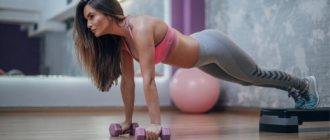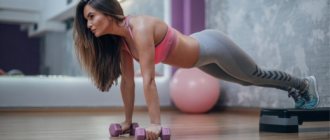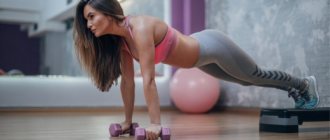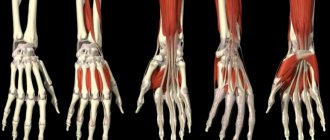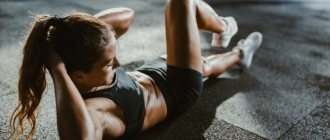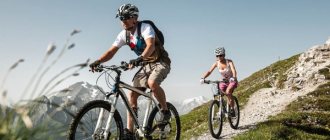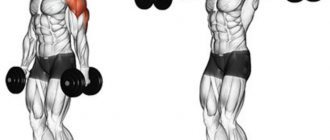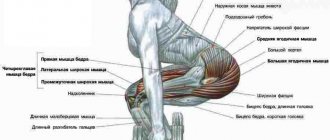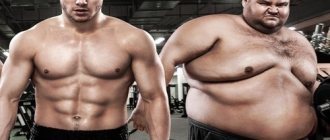How to warm up before training?
Absolutely all leg muscles can be pumped up to a voluminous and sculpted state, without even setting foot in the gym. There would be a desire. For this, there are highly effective exercises performed with your own weight, or with weights/dumbbells, or even with weights “from improvised material”. The secret to pumping up your legs at home is this:
- you need to be patient and make your classes regular, and not “from time to time”;
- try to perform all the leg exercises described below exclusively technically (detailed descriptions of the correct technique are available for each exercise);
- eat well all the time and always get enough sleep so that you can spend every workout in an alert and fresh state.
First of all, we will do a lot of squats - with weights (barbell or dumbbells, kettlebells or fireproof cabinet, etc.) - this is the main exercise to pump up the legs. It puts pressure on the cartilage and puts strain on the ligaments. If the technique is incorrect, or when performing squats without a warm-up, the cartilage in the knee joints is inevitably worn out, and the ligaments are injured.
This is fraught with very serious (albeit delayed) problems with the joints. First of all, with the knees, and in second place - with the ankles. That is, at first you may not even feel any injury, but then... It’s better not to even talk about it. Therefore, if you want to pump up your legs without causing damage to your knees, always perform exercises to pump up your legs only after a good warm-up.
This does not mean at all that for a good warm-up you need to run 10 km or travel around the entire area on a bicycle. It is enough to perform a few simple warm-up exercises, jumping rope. And also - do a couple of warm-up approaches before starting to work with weights. Many people neglect this too. But - it’s impossible! Take your warm-up seriously, “warm up” powerfully and diligently!
Pumping your legs
Having mastered the basic principles of training, you can move directly to sports exercises. When thinking about how to pump up your legs at home, you should remember that there is no fundamental difference in leg exercises for men and women. The only difference is the additional load. Therefore, if someone is interested in how to pump up a man’s legs, he may well use “female” sets of exercises.
The coolest sets of leg exercises for men
When solving the problem of how to quickly pump up your legs, it is not at all necessary to devote a separate training day to your legs. For high-quality pumping, leg exercises can be combined with working out other muscle groups. For example, the abdominal muscles or pectoral muscles.
In this situation, your striking complex will consist of two exercises for the front of the thigh; two for the hamstrings and two for the calf muscles. Plus four more exercises for the chest or abs. In total, we get ten exercises - a working complex designed just for an hour-long workout (or a little more than an hour).
The first version of the home training complex will look like this:
- Squats with a kettlebell or dumbbell: 4x15-20;
- Jumping lunges: 4x16-20;
- Lying leg curls with a dumbbell: 4x15-20;
- Deadlift with a kettlebell or dumbbell: 4x15-20;
- Calf raises on each leg alternately: 4x20-30.
Second option:
- Jump squats: 4x20-30;
- Lunges with dumbbells forward and to the side alternately: 4x15-20 on each leg;
- Kettlebell row from the floor on straight legs: 4x20-30;
- Lying leg curl with gateel: 4x15-20;
- Seated calf raise with weights on the hips: 4x20-30.
Many people, when it comes to how to build big legs, remain very knowledgeable theoretically, but their practical implementation is constantly lame. It is not enough just to know how to pump up huge legs: it is important to show patience and perseverance, exercising regularly and not working half-heartedly in these classes.
Therefore, all really pumped up guys have the same secret on how to properly pump up their legs at home. It’s not easy to create a cool work complex for yourself, but also persistently, week after week, follow it, periodically changing the exercises for variety.
Before each workout, you must know exactly what exercises you will do now, and not neglect any of them in the future.
Principles of sports activities
Before you start thinking about how to pump up your leg muscles, you need to understand the basic principles of successful sports training.
- Preheating principle. Before each lesson, be sure to do a warm-up. It will warm up the muscles, increase blood flow to them, and increase their elasticity. This will help avoid sprains and injuries.
- The principle of systematicity. Exercises must be done regularly. You don't have to practice every day. You can develop a specific training regimen for yourself and stick to it. It is better to exercise every other day or every two days with moderate intensity than once a week “for wear and tear”.
- The principle of optimal intensity, load and time. According to him, you don’t need to overload yourself and train for too long. The assumption of beginners that the longer and more intensively you practice, the more noticeable the result, is a misconception. Too much stress can overwork your muscles and throw you off your training schedule. The intensity depends on the training schedule, the speed of the movements and the rest between them.
- The principle of uniformity. During sports activities, you need to pay due attention to all muscle groups (10 minutes each at first) so that their development occurs evenly and harmoniously.
- The principle of consistency. When performing sports exercises, you should adhere to a certain order of working out different muscle groups. First you need to work on large muscles, then small ones. Specifically: start with the abdomen, then move on to the muscles of the hips, chest, back, shoulder (deltoid, triceps, biceps), forearm, lower leg.
- The principle of progression. As you “master” certain loads, you need to gradually increase the number of approaches, repetitions and additional load.
If anyone is interested in how to quickly pump up your legs, then there is only one answer: follow the above principles as much as possible.
The best exercises for leg muscles
When answering the question of how to pump up your legs at home, the emphasis should first of all be on basic (multi-joint) leg exercises. If anyone doubts: how can you pump up your legs at home, just with squats, or what? – then there is a confident answer to this. Yes, you can build strong legs just by doing weighted squats.
Other exercises at home will only serve as auxiliaries in relation to squats to pump up your legs. So far we are talking only about the upper part of the legs, of course: the thigh muscles. The calf muscles swing in a completely different way: there are effective exercises for swinging this part of the legs. Let's start with them, why not?
Calf raise
To perform this exercise you will need any step. It is not necessary to have a special step platform: the step of any staircase, or concrete blocks, or bricks will do. You need to stand with your toes on this support so that the back, heel, part of the foot is suspended. By lowering our heels down and rising on our toes with as much amplitude as possible, we pump up the strong and voluminous muscles of the lower legs - the lower legs.
In addition to the desire to work with maximum amplitude, in the technique of this exercise it is also important to maintain a slow rhythm of movements. Pay special attention to this: a common mistake is to perform calf raises with quick, jerky movements. But there is no need for these “convulsions”, let all repetitions be slow and controlled.
The calf muscles grow in everyone who trains them regularly. It is a common belief that calves grow slower and are heavier than other muscles. Nothing like this! It’s just that people, as a rule, don’t work these muscles enough and irregularly, simply neglecting to train them, that’s all.
In fact, there are only two effective exercises in the athletes’ arsenal for pumping up the calf muscles. These are calf raises - standing or sitting. And both of them are available for use in home training settings.
Leg extensions with weight on feet
This exercise is valuable because in it the torso and hips do not waste energy on stabilizing functions. This makes it possible to concentrate entirely on the work of the leg muscles. In addition, in this situation there is no additional stress on the joints, ligaments and muscles of the knees. An important point to build up your leg muscles without getting injured!
It makes sense to start this exercise immediately after you have pumped up the lower part of your legs (how to pump them up is in the previous section: raising your toes). Here the calf muscles will rest, and only the quadriceps will be involved in the work.
And the ideal continuation after extensions is lunges with dumbbells - another effective and easy-to-do exercise at home.
Side Lunges
Pumping the leg muscles with dumbbells can and should be varied - doing lunges both forward and to the side. This will help to evenly work both the external and internal muscles of the legs. Specifically, side lunges allow you to qualitatively work out such a problem area for many as the inner surfaces of the thighs (unlike classic lunges).
In the starting position, your feet are shoulder-width apart, your toes slightly pointed to the sides. As you inhale, take a wide step to the side. The working leg bends at the knee joint, the foot gently lowers to the floor, and the center of gravity is transferred to it. The second leg, extended to the side, is kept in an absolutely straight position. The back is straight, but a slight tilt of the body forward is still acceptable.
Back lunges
This variation, called reverse lunges, effectively targets the quadriceps and gluteus maximus muscles. Performing it regularly is a great way to give shape and texture to your legs and roundness to your buttocks. Do this movement either with your own weight or with dumbbells or kettlebells in your hands.
From the starting position - the feet are narrower than shoulder width - the supporting leg is taken back and placed on the toe, while squatting on the working leg. During this movement, the torso remains level, with a natural arch in the lower back. The knees of the working legs should not extend beyond the line of the toes. At the lowest point, you need to feel the stretch in the back of the thigh of the working leg.
Jumping Lunges
A multi-joint exercise performed with your own weight, without using any weights. This is one of the most affordable ways to quickly build up leg muscles at home. The work here actively involves the quadriceps, hamstrings, buttocks, and calf muscles.
From the initial standing position, take a step forward - a lunge, until the knee of the front leg is at an angle of 90 degrees. Then a jump is performed while simultaneously changing the position of the legs. After landing, the leg that was in front is behind. The exercise promotes complex load on the leg muscles.
Jump Squat
Another proven solution for everyone who wants to know how to pump up leg muscles “cheap and cheerful.” This exercise belongs to the type of dynamic, or plyometric. It promotes high-quality development of the relief of the leg muscles. And if you do it with dumbbells or kettlebells in your hands, you will also increase the muscle mass of your legs.
Advice on technique. From a squat you need to jump up as high as possible. You must first land on your toes, softly. Then place your feet on your heels. When squatting, spread your knees to the sides and make sure that they do not go beyond the line of your toes.
Leg curl with dumbbell between feet
This exercise is completely isolating, since only the knee joints are involved in the work; the ankles and hips are not used at all. Even very weak legs begin to progress very noticeably with regular use of this movement.
In the starting position, you need to lie on your stomach and hold a dumbbell between your feet. Bending your legs, you need to slowly and evenly pull the weight towards your buttocks. This movement works great on the hamstrings (those muscles located below the buttocks). The movement is elementary. The technique of execution is simple. The main thing is not to make jerking or jerking movements. And also, when extending your legs, do not throw the weight, lowering it to the end: maintain control over each of your repetitions.
Squats
Even if you have the most demanding work schedule in the world and don’t have any time left for training, you can do one single exercise and progress. There is no doubt that squats are the most effective exercise for the leg muscles, based on the most natural and common everyday movement. No other exercise can provide such an impressive increase in muscle mass and muscle strength. Therefore, when we say: we pump our legs, we mean first of all: we squat, and only then all the other exercises.
An important point is the position of the legs. In order to effectively work the rectus muscle and not put excess load on the knee joints, you need to keep your heels off the floor; push with your heels, not your toes; make sure that your knees do not go beyond your toes. To do this, when squats, press your heels into the floor, pull your pelvis back, and don’t slouch your back. If you have a tendency to lean forward and push with your toes when performing squats, then simply place small 5- or 2.5-pound weight plates under your heels.
Here's something else to consider. If you place your feet wide, your buttocks will be involved in the work. If you do deep squats, then, in addition to your legs, you also begin to pump up your butt. If the load on the gluteal muscles is not part of your plans, then choose a narrower foot position and squat shallowly. Approximately to the parallel of your hips and the floor, as if sitting on a chair. To get used to not squatting too deeply, you can first even set up a bench for yourself and squat only until your buttocks touch the surface of the bench. But do not plop down on this bench with all your weight, but lightly touch it with your buttocks and immediately begin moving upward.
Deadlift on straight legs
In order to pump up your leg muscles at home, you will need another extremely effective exercise - straight leg deadlifts. It develops the back of the thigh - its biceps.
It is one of the varieties of deadlift. The purity of technique plays a greater role here than anywhere else. And learning to do this exercise is not easy. The most important thing is to get used to “turning off” your back and learn to lift weights with your biceps. To do this, you need to move your chest slightly forward (as if inflating it with a wheel), and bend your back at the lower back and fix this deflection. Now, when bending forward, we do not round our back, but move our pelvis back. Straight arms with weights simply hold the weight sliding down close to the line of the legs.
When the technique of this exercise is one hundred percent successful, you will feel the characteristic stretch in the hamstrings that occurs when straightening your torso at the top of each repetition.
What equipment do you need to train at home?
To perform some exercises you will need dumbbells. If you don't have them, fill 1-1.5 liter plastic bottles with water.
Use furniture as a means of support to lean on. A table, cabinet with shelves, chair, or other object that is comfortable to rest your legs or arms on will be useful for doing stretches or leg swings. The chair is an almost universal exercise machine. With its help, reverse push-ups, hyperextensions and various exercises for the buttocks are performed.
Photo: istockphoto.com
Do you need sports nutrition for home workouts?
It is impossible not to mention that in the question of how to properly pump up your legs, nutrition plays an important role (as in the development of other muscle groups). Of course, in order to pump up your legs, regular and technically performed exercises are first of all important. If you support them with proper nutrition, progress will go faster.
The question is often asked: is sports nutrition necessary when training at home? Like, if you study at home, then you should only eat homemade food, so what? I would like to emphasize. It doesn't matter where you train, it matters how you train. If you’ve worked out with good dedication at home and toned your muscles properly, then a good boost in the form of a hefty portion of a protein shake will definitely not hurt them.
The same thing with pre-workouts and pills. If you come home from work feeling like a lemon, can you get the maximum benefit from your evening workout? Hardly. And the pre-workout complex will increase your tone. It will help you feel energetic and fresh and will contribute to a bright and productive training. Otherwise, it will just be a sluggish exercise “through force”, “about nothing”.
For those who are just deciding whether they need sports nutrition, we recorded a video below:
Of course, sports nutrition will not completely ensure your progress. However, it can speed it up significantly. In nature, plants that receive more nutrients grow and develop faster. Also muscles. Substances vital for their growth, the “building material” for new muscle fibers, are protein and amino acids. And it doesn’t matter whether we are dealing with training in a fitness club or with home training, for rapid progress we need to give our body high-quality “fuel”. Therefore, feel free to put your muscles to the test, but also smartly “feed” them at the same time!
0 9
Did you like the article? Share with friends:
We recommend reading:
How to pump up a girl’s arms at home – exercises with and without dumbbells
How to pump up your forearms at home - the best exercises
Exercises for hands to prevent sagging skin - pump up your hands at home!
Triceps on a block - types of pull-downs and extensions
Biceps exercises with dumbbells at home and in the gym - the best options for lifting and bending
How to pump up your legs at home: the benefits of exercise
It is worth highlighting a number of reasons why training for the lower extremities is so necessary for a person:
- the largest muscle component of the body is localized in this part of the body;
- Conducting comprehensive training makes it possible to speed up metabolic processes and burn extra calories;
- working on the leg muscles can improve the results of training in general and improve the growth of muscle tissue;
- during the development of this group of muscles, there is a release of a significant amount of hormones that are directly involved in the processes of building the body;
- impact on the development of tissues of the back, shoulder girdle and arms;
- increase in endurance, as well as strength indicators;
- symmetrical figure;
- improvement of muscle-neural interaction;
- protection of knee joints from possible injuries;
- improving the functioning of the cardiovascular system.
The main function of the muscle tissue of the legs is to directly activate the musculoskeletal system. This group is considered the strongest. Moreover, all components have a narrow and elongated variety.
